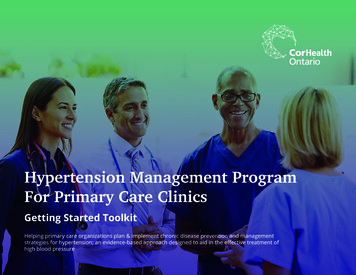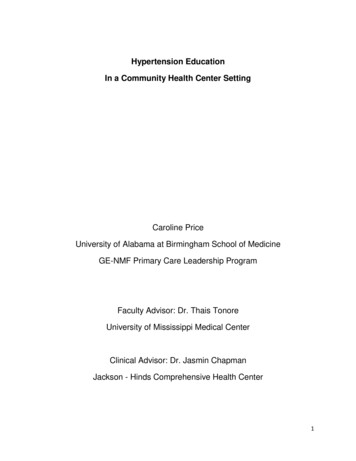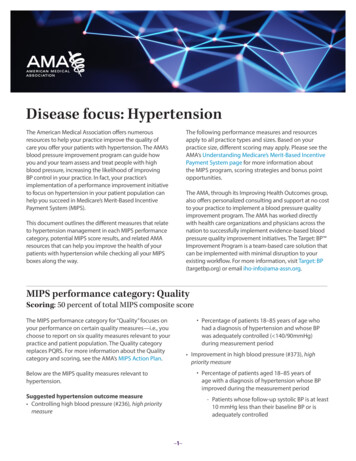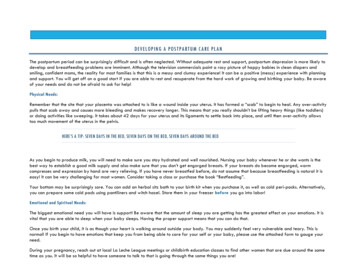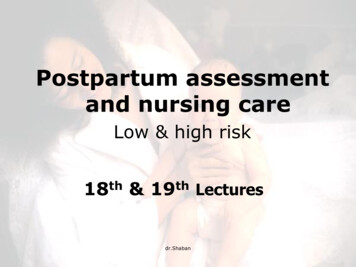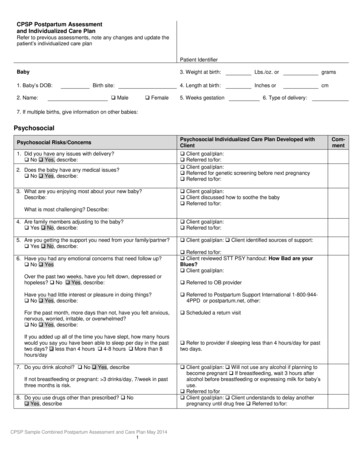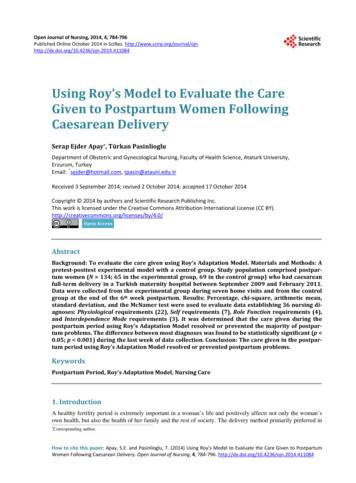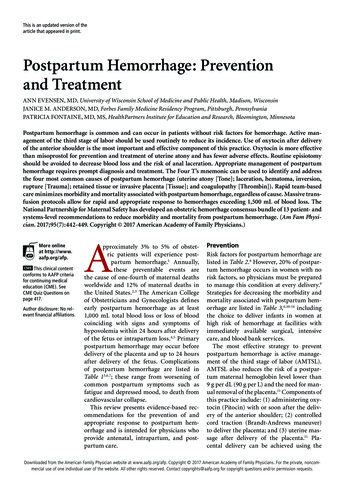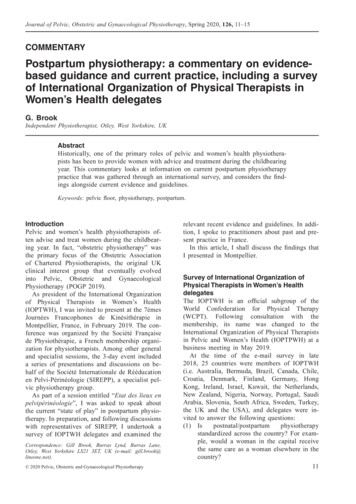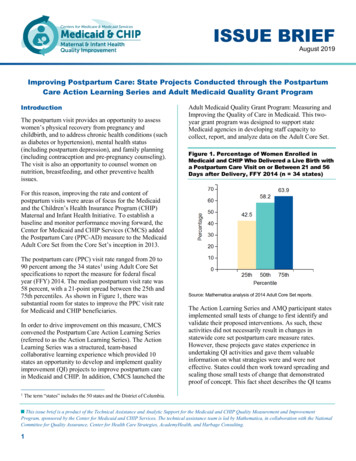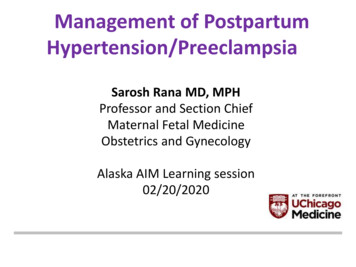
Transcription
Management of PostpartumHypertension/PreeclampsiaSarosh Rana MD, MPHProfessor and Section ChiefMaternal Fetal MedicineObstetrics and GynecologyAlaska AIM Learning session02/20/2020
STAMPP-htnSystematic Treatment And Management ofPostPartum hypertensionClinical guidelines and protocolsHospital level initiatives for management of postpartum hypertensionFunding : Department of OB/GYN, CLI Board, Women’s Board, Omron
POINTS TO DISCUSS What is preeclampsia Why is it important to worry about preeclampsia Why worry about BP after delivery What are some local measures one can take to identifypreeclampsia to mitigate risk to mothers and babies
PREECLAMPSIA Common hypertensive disorder of pregnancy 5-7 % of pregnancies 70,000 maternal deaths and 500,000 fetal deaths/year worldwide Associated with long term cardiac and renal complications HTN, CVD risk, stroke, dementia and death Lack of physician awareness 56% of internists and 23% of ob-gyns were unsure or did not knowwhether preeclampsia is associated with ischemic heart disease Only 9% of internists counseled women who had preeclampsia aboutcardiovascular risk reduction AA women 3-4 times at higher risk of dying from pregnancy relatedcomplications and preeclampsia a common cause of serious maternalmorbidity and death
IMMEDIATE COMPLICATIONS OFPREECLAMPSIA Placental abruption HELLP syndrome Eclampsia Liver and kidney damage Fetal growth restriction Preterm birth Cardiomyopathy Maternal /fetal death
LONG TERM RISKS OF PREECLAMPISA Increased risk of cardiovascular disease (CVD) such as hypertension,myocardial infarction and congestive heart failure, cerebrovascular event(stroke), peripheral arterial disease and cardiovascular mortality later in life Women with a hypertensive disorder of pregnancy have 12- to 25-fold higherrates of hypertension than women with a normotensive pregnancy in the yearafter delivery Increased risk of end stage renal disease, stroke and dementia Lack of physician awareness– 56% of internists and 23% of ob-gyns were unsure or did not knowwhether preeclampsia is associated with ischemic heart disease– only 9% of internists counseled women who had preeclampsia aboutcardiovascular risk reductionACOG practice Bulletin, Gestational hypertension and preeclampsia, 2019.Rana S. Physicians' knowledge of future vascular disease in women with preeclampsia. Pregnancy HTN, 2012;31(1):50-8
LIFE SAVING INTERVENTIONS What can you do at your hospital level
Our hospital journey Participate in ILPQC- treatment of acute severe HTN ,huddle and discharge instructions STAMPP- HTN- Systematic Treatment And Managementof PostPartum hypertension 85% of patients are AA and majority are obese
Illinois Perinatal QualityCollaborative (ILPQC):Severe Hypertension in Pregnancyand Improving Time to Treatment
Goals of the Program Improve the timely delivery of antihypertensivetherapy for severely elevated blood pressures Document potential barriers to care Develop potential strategies to improve delivery andquality of care Allows for individual hospital and statewideassessment
What is the program? Timely administration of IV anti hypertensives for severerange blood pressures in pregnancy– Defined as: SBP 160 or DBP 110– Within 1 hour of identification The sooner the better ( within 30 minutes) Standardized form outlining recognition and delivery ofcare– Process and timing of initial delivery of care– Debriefing process for barriers to care– Additional complications and issues encountered during anadmission– Discharge planning and follow-up
Potential for intervention Prior CMQCC Analysis 60% of maternal deaths from preeclampsia had “goodto strong chance” of altering outcomes withintervention In cases of maternal mortality: Delayed response to warning signs in 90% Ineffective care in 70% Misdiagnosed in 40%Main EK, McCain CL, Morton CH, Holtby S, and Lawton ES. Pregnancy-related mortality in California. Obstet Gynecol2015;125:938-47.
Severe Maternal Morbidity Severe maternal morbidity more frequent in women with severeHTN compared to non-severe HTN Frequency of severe morbidity did NOT increase with worseningBP values Suggests that once severe range BPs occur, they requireintervention Higher rates of maternal morbidity seen with: Lower hospital NICU care levels (Level 3 vs Level 4) Lower delivery volumes (Low vs High)Kilpatrick SJ, Abreo A, Greene N, et al. Severe maternal morbidity in a large cohort of women with acute severeintrapartum hypertension. Am J Obstet Gynecol 2016;214:1.e1-1.e7.
Call to Action ACOG has developed Safety Bundles for Severe Hypertension inPregnancy– Risk Assessment and Prevention Diagnostic CriteriaWhen to TreatAgents to UseMonitoring– Readiness and Response Complications and escalation processFurther evaluationChange of statusPostpartum surveillance Bundle– A way to describe a collection of processes needed to effectively carefor patients undergoing particular treatments with inherent risks
Recognition ofHypertensive emergency Measurement of severe hypertension with thepatient in either the seated upright position– SBP 160– DBP 110 Persistent 15 min from initial measurement Recognized as occurring:– Antepartum– Intrapartum– Postpartum
Antihypertensive Agents Intravenous medications preferable– Labetalol– Hydralazine Nifedipine (short-acting) has shown effectiveness as anoral agent– Less experience with the medication Magnesium sulfate and epidurals are NOT consideredantihypertensive agents
Discharge and Follow Up Discharge instructions– Should include review of warning signs andsymptoms for severe manifestations ofhypertension in pregnancy When planning discharge for hypertensive patient– Within 3-7 days if discharged without medication– 72 hours if discharged with medication
CDC 2019
PROBLEMS AT THE LEVEL OF THE HOSPITAL At the time of admission and discharge General lack of knowledge among patients about long term effects ofpreeclampsia No organized effort for education to patients Discharge instructions not universally given No dedicated postpartum clinic for easy access to care Problems with readmissions in ED Identifying post partum patients Incorrect Treatment of PP HTN Poor knowledge about definition of severe for PPHTN Calling medicine or cardiology instead of OB Delayed transfer to L/D Delay in recognition and treatment of severe PPHTN No standardized management for readmissions for PPHTN
Preeclampsia EducationalVideohttps://www.youtube.com/watch?v hVPxFZDEFZI
STAMPP-HTNprogram FBC Video- Care network Nursing- FBC Written instructions- EVS Tear pad Bracelets BP cuff and monitors Preeclampsia dischargechecklist Postpartumpreeclampsia care Standardized all protocols Management of PPHTN PPHTN clinics Readmissions ED workflowPreeclampsia Educational Videohttps://www.youtube.com/watch?v hVPxFZDEFZIPOSTPARTUM PREECLAMPSIA CARETAKING YOUR BLOOD PRESSURE AT HOMEKnow PreeclampsiaSymptoms Headache that won’t goaway Visual disturbances(seeing spots or auras) Epigastric pain (upperright quadrant)Rest in a chair at least 5 minutes before taking blood pressureMake sure your relaxed, still, and don’t talkYour legs should be uncrossed and feet flat on the floorDo not smoke, exercise, drink caffeine or alcohol 30 min beforetaking blood pressureTake at least 2 readings a day: One in the morning before takingyour medication and one in the evening. Record all results.Take your blood pressure monitor with you to your 1 week clinicappointment. The provider will review your stored bloodpressures in your blood pressure monitor.IMPORTANT INFORMATION: My 1 week preeclampsia follow-upappointment is on Blood pressure medications prescribed: Sudden weight gain Breathlessness(difficulty breathing) Swelling of the face,legs, or hands “just not feeling right”;unexplained “anxiety”KNOW YOUR RISKSSEIZURESSTROKEORGAN DAMAGEDEATH How to get help For medical emergencies call 911 If your blood pressure is 160 or greatersystolic (top number)/110 or greaterdiastolic bottom number, go to theemergency room for evaluation. For Postpartum hypertension clinic call773-702-6118MONITOR YOUR BLOODPRESSURE AT HOMETAKE YOUR MEDICATIONS*GET FOLLOW-UP CARE*
STANDARDIZED PROTOCOLSFOR MANAGEMENT OF PPHTN
PPHTN clinics Follow up in PPHTN clinic Appointments before discharge Standardized Protocol for treatment of HTN Patient to be sent to L/d for severe HTN Long term follow up with cardiology
Post Partum HTN ClinicPopulation: Preeclampsia, SuperimposedPreeclampsia, and Gestational HTNGoal 140/90SBP 160 and/orDBP 110persistent for 15minutesTriage to L&D 26639*Follow PRICEAlert MFMAttendingFollow up withpharmD orcardiology perhospital dispoSBP 150-159and/or DBP 100without alertsymptomsIncrease dose by30-50% and/oradd labetalol ornifedipine XL1 week followup: 150/100then 6 week PPcardiology visitSBP 140-150 &DBP 90- 100Regimen highdoses of 2agents? Pagecardiology 9189Order CMP,CBC w/ diff,P/C ratioAbnormalities?Alert MFMattending IfAdmit MFMFollow up BP 150/100, w/normal labs, titratemed(s)Follow up in 2weeksSBP 150 orDBP 100 thenfollow orangeprotocolBP 150/100follow up 6 weekPP withcardiologySBP 140 &DBP 90Taper regimen 3050% but stop if 120/80Patient to callif SBP 150 orDBP 1006 week PPcardiology appt29461
Goals Improve knowledge amongproviders and patients Appropriate and timelymanagement of HTN Reduced rates HTN relatedcomplications Improve rates of PP follow up Appropriate management ofreadmissions for HTN Improve long term BP control Follow up with cardiologySustainability/ Future- Nurses involvement- Education of all care providers andcompetency training (worldpreeclampsia day, facebook live,webinars)- Data collection to show qualityimprovementTEAMWORK
Results80%69.14%70%60.00%60%N 495 patients80% were AfricanAmerican68% had MedicaidMedian age was 28 years52.73%46.90%50%40%30%26.83%31.58%20%10%0%SEP / OCT2018NOV / DEC2018JAN / FEB2019MAR / APR2019MAY / JUN2019JUL / AUG2019 Median [IQR] systolic BPs immediately post-delivery were higher inthe beginning of the study period as compared to the end (152[139,161] vs 139 [133,150]; p 0.0001). A significant increase in PP antihypertensive use was also observed(34.2% vs 45.6%, p 0.04). Assess engagement with healthcare at 6 weeks and 1 year
First TrimesterAfter 20 weeksPostpartumEducation to patients
WHERE TO BEGIN. Create a team with diverse members (OB physicians, nurses,anesthesiologist, pharmacist, managers) Compare your hospital with the bundle elements Gap analysis Focus on areas that may be easiest to implement (get an easy win) Identify potential barriers and honestly address them Communication, Response & Reliable Processes High risk huddles and debriefing Simple debrief Timely and easy to doShould provoke awareness and ideasIdentifies problem areas, confirms best practicesPlan for follow-up and reporting back to staff Post the process- pocket note book, bulletin boards, posters,food/networkingILPQCCMQCC
Our teamColleen Duncan, RNMacaria Solache- RNJamila Pleas, RNMelissa Benesh , FBCMacaria Solache- RNNatali Horab, DCAMElizabeth Delgado, RNSamantha D Reyes- FellowVictoria Oladipo- MS IIHeba Naseem, RAHarjot Kaur, RASarosh Rana- MFMFunding: CLI Board Women’s Board Omron
Thoughts Questions
20.02.2020 · whether preeclampsia is associated with ischemic heart disease –only 9% of internists counseled women who had preeclampsia about cardiovascular risk reduction LONG TERM RISKS OF PREECLAMPISA ACOG practice Bulletin, Gestational hypertension and preeclampsia, 2019. Rana S. Physicians' knowledge of future vascular disease in women with preeclampsia. Pregnancy HTN,
